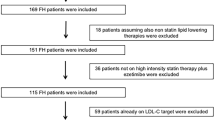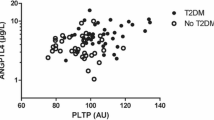Abstract
Background: HMG-CoA reductase inhibitors (statins) can effectively reduce serum low-density lipoprotein cholesterol (LDL-C) levels in the majority of patients at increased cardiovascular risk. However, some patients at increased cardiovascular risk have a high peripheral leukocyte count and this inflammatory marker has correlated with an increased incidence of coronary events. Recently, in a large clinical trial-based cohort, an increasing on-statin cholesteryl ester transfer protein (CETP) mass was inversely related to coronary events, particularly among those with a low serum LDL-C level. However, the role of the CETP mass in the development of atherosclerosis is still unclear.
Objective: We investigated the possibility of whether the CETP mass was associated with the peripheral leukocyte count after intensive statin therapy, and whether the CETP mass was changed by switching statins.
Methods: This study was an open-label lipid interventional study switching from atorvastatin to pitavastatin without a washout period. Between 1 April 2010 and 31 March 2011, 32 patients (mean age 64.0 ± 9.0 years, 63% male) with hypercholesterolemia receiving atorvastatin (10mg/day) were enrolled. Next, they were switched to pitavastatin (2 mg/day) for 6 months. The peripheral leukocyte count, the CETP mass measured by enzyme-linked immunosorbent assay, and lipid parameters were measured at baseline and at follow-up. The type and dosage of concomitant drugs were not changed during the study periods.
Results: The on-atorvastatin LDL-C level was well controlled with 94.4 ± 23.1 mg/dL, and peripheral leukocyte count was 6209 ± 1142 cells/mL. On atorvastatin therapy, the CETP mass correlated negatively with the peripheral leukocyte count (r = −0.418, p = 0.02). In univariate regression analysis, onatorvastatin peripheral leukocyte count was significantly correlated with high-density lipoprotein cholesterol (β = −42.1, p = 0.008), triglycerides (β = 8.2, p = 0.005), and the CETP mass (β = −1296.3, p = 0.02). In a multivariate analysis after adjusting for traditional risk factors, the CETP mass remained an independent negative determinant of the peripheral leukocyte count (β = −1162, p = 0.02). By switching atorvastatin to pitavastatin, the CETP mass was significantly increased from 1.9 to 2.1 mg/mL (8.8%, p = 0.007), and the peripheral leukocyte count was significantly decreased from 6209 to 5778 cells/mL (-5.9%, p = 0.005). As a result, the relationship between CETP mass and peripheral leukocyte count after pitavastatin treatment was diminished (r=−0.276, p = 0.13). Moreover, the change in peripheral leukocyte count was negatively correlated with the change in the CETP mass (r = −0.39, p = 0.03), suggesting that a decreased CETP mass may be closely associated with an elevated peripheral leukocyte count in atorvastatin-treated patients.
Conclusion: The results suggest that residual cardiovascular risk after atorvastatin treatment may be associated with the CETP mass, which may be increased by switching to pitavastatin. Furthermore, a CETP mass-activating strategy may assist the therapeutic efficacy of statins.





Similar content being viewed by others
References
Barter PJ, Caulfield M, Eriksson M, et al. Effects of torcetrapib in patients at high risk for coronary events. N Engl J Med 2007; 357: 2109–22
Nissen SE, Tardif JC, Nicholls SJ, et al. Effect of torcetrapib on the progression of coronary atherosclerosis. N Engl J Med 2007; 356: 1304–16
Cannon CP, Shah S, Dansky HM, et al. Safety of anacetrapib in patients with or at high risk for coronary heart disease. N Engl J Med 2010; 363: 2406–15
Khera AV, Wolfe ML, Cannon CP, et al. On-statin cholesteryl ester transfer protein mass and risk of recurrent coronary events (from the pravastatin or atorvastatin evaluation and infection therapy-thrombolysis in myocardial infarction 22 [PROVE IT-TIMI 22] study). Am J Cardiol 2010; 106: 451–6
Yamashita S, Tsubakio-Yamamoto K, Ohama T, et al. Molecular mechanisms of HDL-cholesterol elevation by statins and its effects on HDL functions. J Atheroscler Thromb 2010; 17: 436–51
Poolsup N, Suksomboon N, Wongyaowarat K, et al. Meta-analysis of the comparative efficacy and safety of pitavastatin and atorvastatin in patients with dyslipidaemia. J Clin Pharm Ther 2012; 37: 166–72
Teramoto T, Shimano H, Yokote K, et al. Effects of pitavastatin (LIVALO Tablet) on high density lipoprotein cholesterol (HDL-C) in hypercholes-terolemia. J Atheroscler Thromb 2009; 16: 654–61
Madjid M, Awan I, Willerson JT, et al. Leukocyte count and coronary heart disease: implications for risk assessment. J Am Coll Cardiol 2004; 44: 1945–56
Mezdour H, Kora I, Parra HJ, et al. Two-site enzyme immunoassay of cholesteryl ester transfer protein with monoclonal and oligoclonal antibodies. Clin Chem 1994; 40: 593–7
Hirano T, Ito Y, Yoshino G. Measurement of small dense low-density lipoprotein particles. J Atheroscler Thromb 2005; 12: 67–72
Barter P, Gotto AM, LaRosa JC, et al. HDL cholesterol, very low levels of LDL cholesterol, and cardiovascular events. N Engl J Med 2007 Sep 27; 357 (13): 1301–10
Nicholls SJ, Tuzcu EM, Sipahi I, et al. Statins, high-density lipoprotein cholesterol, and regression of coronary atherosclerosis. JAMA 2007; 297: 499–508
Tani S, Nagao K, Anazawa T, et al. Coronary plaque regression and lifestyle modification in patients treated with pravastatin: assessment by mainly daily aerobic exercise and an increase in the serum level of high-density lipoprotein cholesterol. Circ J 2010; 74: 954–61
Cazita PM, Barbeiro DF, Moretti AI, et al. Human cholesteryl ester transfer protein expression enhances the mouse survival rate in an experimental systemic inflammation model: a novel role for CETP. Shock 2008; 30: 590–5
Föger Chase M, Amar MJ, et al. Cholesteryl ester transfer protein corrects dysfunctional high density lipoproteins and reduces aortic atherosclerosis in lecithin cholesterol acyltransferase transgenic mice. J Biol Chem 1999; 274: 36912–20
Plump AS, Masucci-Magoulas L, Bruce C, et al. Increased atherosclerosis in ApoE and LDL receptor gene knock-out mice as a result of human cholesteryl ester transfer protein transgene expression. Arterioscler Thromb Vasc Biol 1999; 19: 1105–10
Westerterp M, van der Hoogt CC, de Haan W, et al. Cholesteryl ester transfer protein decreases high-density lipoprotein and severely aggravates atherosclerosis in APOE*3-Leiden mice. Arterioscler Thromb Vasc Biol 2006; 26: 2552–9
Yoshida A, Kodama M, Nomura H, et al. Variability in cholesteryl ester transfer protein in healthy Japanese hyper-HDL-cholesterolemic subjects. Internal Medicine 2002; 41: 357–9
Martin G, Duez H, Blanquart C, et al. Statin-induced inhibition of the Rhosignaling pathway activates PPAR alpha and induces HDL apoA-I. J Clin Invest 2001; 101: 1423–32
Kobayashi M, Gouda K, Chisaki I, et al. Regulation mechanism of ABCA1 expression by statins in hepatocytes. Eur J Pharmacol 2011; 662: 9–14
Acknowledgments
No funding was received for this study. None of the authors have any conflicts of interest that are directly related to this study. We thank Mr Kenji Kawamata for helpful discussions and statistical analysis.
Author information
Authors and Affiliations
Corresponding author
Rights and permissions
About this article
Cite this article
Tani, S., Nagao, K. & Hirayama, A. Association of Cholesteryl Ester Transfer Protein Mass with Peripheral Leukocyte Count Following Statin Therapy. Am J Cardiovasc Drugs 12, 349–354 (2012). https://doi.org/10.1007/BF03261844
Published:
Issue Date:
DOI: https://doi.org/10.1007/BF03261844




